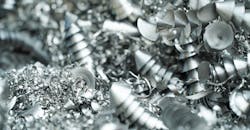5 Safe & Effective Strategies for Waste Management
Today’s CNC machining operations are remarkably efficient. Still, all machining entails some amount of waste in the form of removed material and used coolants. Consequently, waste management is a critical consideration for any CNC machining operation.
Managing production waste is a matter of both safety and efficiency. An improper disposal strategy leads to excessive costs or workplace hazards, while an optimal one yields improvements in these areas. Here are five methods to consider to make the most of waste disposal in your CNC machining operation.
1. Minimize waste where possible
The best way to handle waste is to prevent it. While it may not be possible for all facilities to eliminate waste entirely, implementing a few operational changes will go a long way. Adopting 3D printing instead of machining where possible is an example, as additive manufacturing does not generate waste in the same volume that subtractive manufacturing will do.
Automation is a more practical solution solution. Robotic CNC machines offer greater precision and repeatability, and this makes them less likely to produce unnecessary scrap or defective components.
As many as 71.68% of production sequences in some factories contain errors. Automation can help reduce the number of mistakes. In turn, this will decrease the volume of scrap you need to manage.
Further treatment and disposal steps may still be necessary, but volumes will be much lower, making it easy to manage.
2. Recycle metal
Recycling is another important step. In cases where you cannot prevent material scrap, you may be able to collect and reuse it to avoid more complicated and expensive waste management methods.
The world recycles less than 10% of its products, which does not include raw materials, leaving substantial room for improvement. In CNC machining, this is often as simple as gathering shavings from the shop floor and returning them for melting into usable material. However, there are a few hazards to consider here.
Scrap metal may collect contaminants throughout the production process, and those additions could hinder recyclability. Foundries and secondary metal processors can address this by cleaning shavings before remelting and refining the recycled metal, and those processes may incur extra costs. If the recycling process is managed within a single operations there may be savings in the amount of virgin material needed.
3. Reuse coolants
You can apply the same principle to CNC machine coolant disposal. Many manufacturers miss this opportunity because fluids may fall under the EPA’s definition of hazardous materials. However, the EPA encourages hazmat recycling, as it minimizes energy use and pollution as long as you follow safe reuse guidelines.
Some coolants — such as soluble oils — require minimal processing to recycle. You can often pass them through a filter and cycle them back into the CNC mill. Straight oils and synthetic fluids may require antimicrobial agents or other additives to remove contaminants and restore the material to its original properties.
Regardless of what type of coolant you use, make sure all hoses, tanks and other parts of the system are clean and leak-free. Any breaches or grime buildup will make it harder to reuse the material safely.
4. Monitor waste contents
Ongoing monitoring is important for both CNC machine coolant disposal and managing solid CNC waste. Handling used material depends on its makeup, which can vary widely depending on the contaminants it encounters. Consequently, keeping tabs on its contents is vital when determining when you can recycle something and when you must get rid of it.
When coolant requires so many additives that the material costs equals or exceeds that of new fluids, it’s time to dispose of it. Similarly, metal shavings containing consequential levels of chemical contaminants may be best sent to a certified recycling facility instead of reusing them in-house.
You can sample waste streams manually, but Internet of Things sensors are more efficient. IoT devices enable continuous monitoring, providing more detailed insights while alerting you once contaminant levels reach unacceptable levels.
5. Separate to streamline
When it comes time to dispose of CNC machining waste, separation is key. It may seem like a small step, but separating materials before further processing offers one last chance for recycling and minimizes handling costs.
Coolant concentrations linger around 5% to 10%, meaning they’re up to 95% water. By evaporating the water from these solutions before disposal, you’ll dramatically reduce the material you must pay a certified waste management company to handle. This process also minimizes storage concerns.
Solid waste also benefits from separation. Sifting scraps into magnetic and non-magnetic groups or sorting them by size makes it easier to know what to do with them. Once you’ve organized it, you can determine what you can reuse and what needs special treatment and disposal.
Dispose of waste properly
CNC machining produces considerable waste at times but proper management can reduce its impact. Employing strategies like these will let you lower your operating costs, promote workplace safety and minimize your environmental footprint.
Waste management methods are most effective when you combine multiple approaches. Experiment with a few options today to find what works best for your facility.
Emily Newton is the Editor-in-Chief of Revolutionized, an online magazine exploring the latest industrial innovations.
